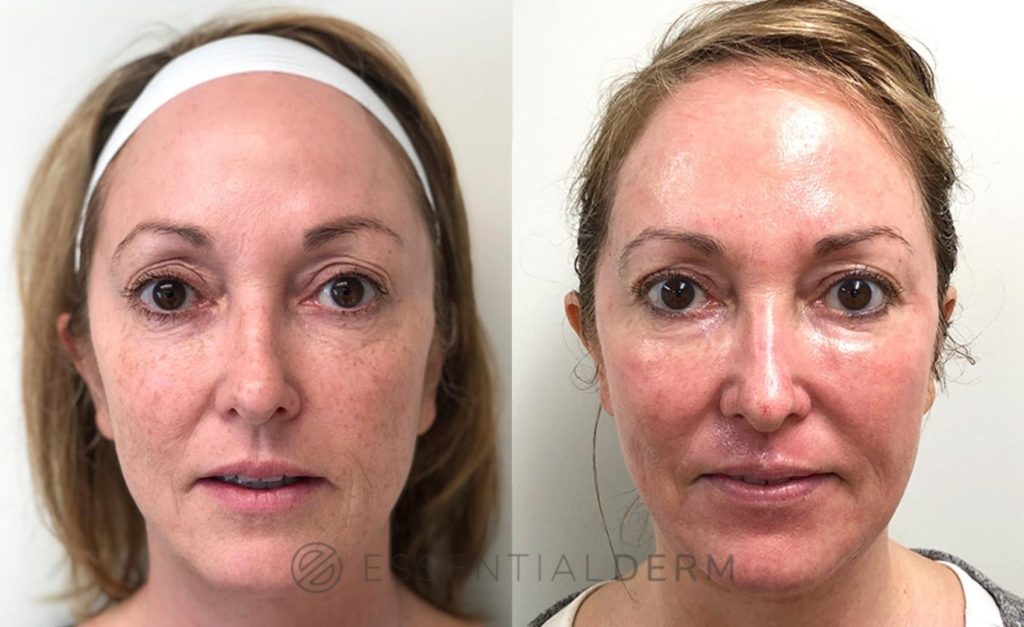
20
Sep
REAL RESULTS: LUMENIS ULTRAPULSE® BEFORE AND AFTER

Are you tired of temporary fixes for long-term skin concerns? When topical treatments no longer meet your needs, it may be time to consider making a lasting transformation. This blog post will highlight our powerful CO2 laser treatment, Lumenis UltraPulse®. See before and after photos and learn how it works, what it treats, and more below.
What Does the Lumenis UltraPulse CO2 Laser Do?
The UltraPulse CO2 laser uses fractional ablative technology to vaporize microscopic columns of skin while sparing the surrounding tissue. The benefit of fractional technology is faster, safer healing than you’d experience with traditional ablative lasers.
The laser’s energy acts as a catalyst, triggering your body’s natural healing mechanisms to boost collagen production and generate fresh, healthy skin cells.
What Conditions Can UltraPulse CO2 Laser Treat?
The UltraPulse CO2 laser can effectively treat the following skin concerns:
- Wrinkles and fine lines
- Sun damage
- Uneven texure
- Pigmentation issues such as freckles, sun spots, and age spots
- Scars from surgeries, acne, or burns
- Lax, loose skin
The UltraPulse CO2 laser sets itself apart with customization options that allow the treatment to be meticulously tailored to your skincare objectives. Its versatility means that multiple skin conditions can be addressed simultaneously.
Whether you’re interested in a lighter treatment with minimal downtime or a more intensive procedure that may require a longer recovery period, we can adjust your treatment accordingly.
CO2 Laser Before and After: What to Expect
To give you an idea of the results that the UltraPulse laser can achieve, these are photos of actual patients taken before and after their CO2 laser treatment:


Does CO2 Laser Treatment Hurt?
At Essential Derm, we prioritize your comfort throughout the process. A topical anesthetic is applied before treatment, and additional oral medication options are available for those seeking extra precautions.
Many patients describe the treatment as a “pins and needles” sensation or like a rubber band snap against the skin. While there may be some discomfort, it is generally well-tolerated.
CO2 Laser Recovery & Healing Process
Healing after your UltraPulse treatment unfolds in stages and varies depending on the intensity of your treatment. Immediately after treatment, your skin will be red and may feel sensitive and sunburned. Your dermatologist will advise you on how to cleanse and care for your skin as it heals.
The initial wound healing period can range from 5 to 14 days, at which point you may begin using makeup or concealer to camouflage any residual redness.
As you move past this initial phase, your skin will take on a pinkish hue that lasts for several weeks or months. This is normal; your skin will eventually fade to your natural skin tone. During the 6 to 12 months after treatment, you’ll see continual skin improvements as new collagen rejuvenates your complexion.
CO2 Laser Aftercare
A skincare regimen using high-quality medical-grade products designed for your skin type can help you maintain your glow. Sun exposure can compromise the quality of your results, so be sure to use a broad-spectrum, high-SPF sunscreen daily.
Request a Consultation
The Essential Derm team is committed to helping you look and feel your best. To explore the possibilities of Lumenis UltraPulse CO2 laser treatments, call our office at (508) 827-2615 or request a consultation.
Learn more about laser treatments in this related blog post.
